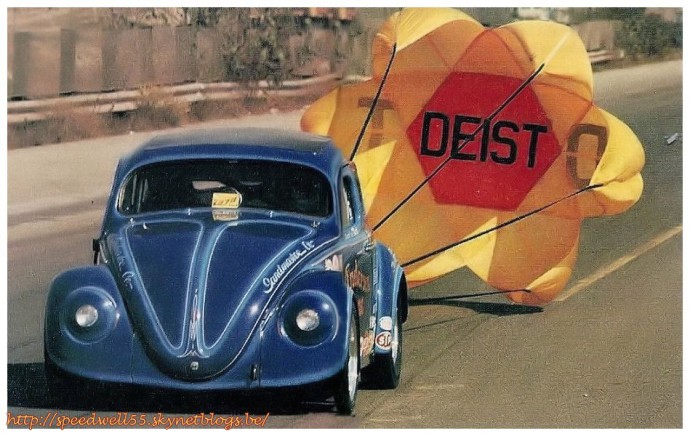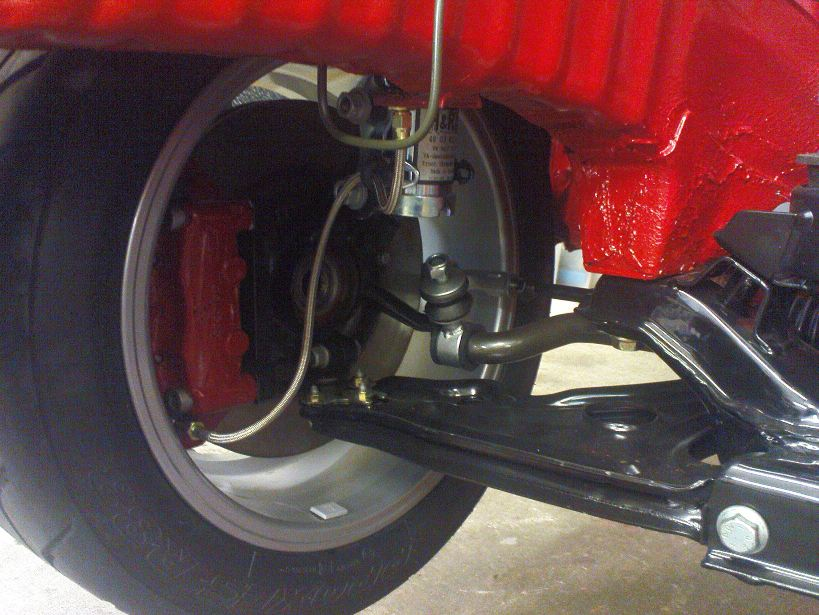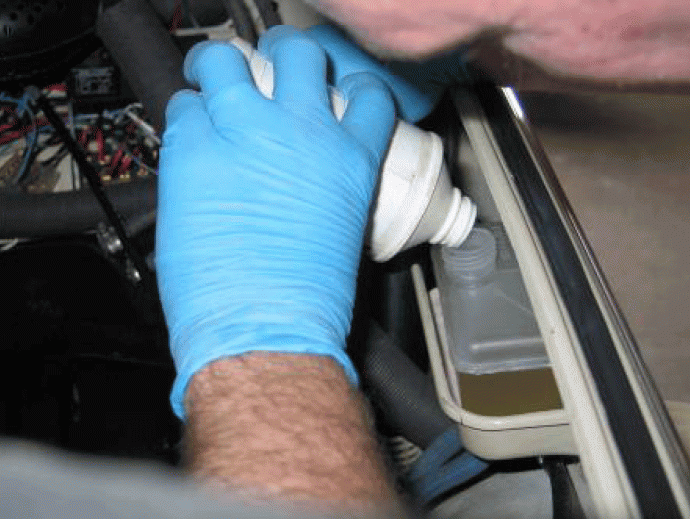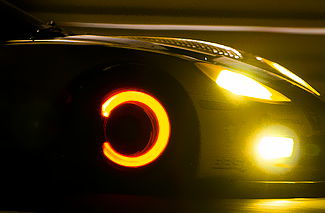Braking is a pretty essential part of motoring. It can be fun if you do it late and get round a corner faster than before, but it can be scary too, potentially leading to disaster if your brakes aren’t up to scratch.
Of course by today’s standards your classic VW brakes are pretty terrible; the lack of servo is enough to send many running for their super-mini with multiple driving aids. But in reality they will work adequately, here is how to make them better!

1.Stop the flex! The hydraulic brake fluid that flows from your master cylinder to each corner of your car is compressed and put under extreme pressure each time you brake. When using normal brake hoses this pressure can be transferred to the side walls of the hose, making the rubber to expand slightly, this takes some of the impact of your braking away from the caliper or wheel cylinder.
Did you know rubber brake hoses are ever so slightly porous? Over their lifetime they will absorb moisture from the atmosphere into your brake fluid making it less efficient, potentially corroding your metal pipes from the inside out (more about that later). This doesn’t mean rubber hoses aren’t safe; they’re just a compromise between cost and performance.

So, want to make things better? We recommend fitting stainless steel brake hoses to your classic to improve this. With their stainless steel construction they prevent atmospheric moisture entering the brake system, and more importantly they won’t “give” under pressure, transmitting all your braking power from the pedal to the wheels, giving you a much more positive braking experience.
2. Bleeding nuisance!? A simple way to make improvements on your brakes and it might not even cost you a penny. Air in the brake fluid creates bubbles, which when you apply the brake pedal will try to be compressed by the fluid, (as they can’t escape anywhere), this stops your valuable pressure making it to the caliper or wheel cylinder with the force you were expecting… cue spongy pedal. You can tackle this yourself with a DIY brake bleeding kit – alternatively, splash out and ask a garage to pressure bleed the system to be certain the air has gone. While you’re there.. check out point 3
3. Fluent in fluids? So…Brake fluid isn’t all the same. The DOT (Department of Transport rating) tells you the quality of the fluid you are dealing with. Our classics will have originally used a DOT 3 or DOT 4 fluid, these both have a percentage of water in them (crazy hey?!). These fluids are classed as hygroscopic, this means they can absorb moisture if not stored properly. That open 5 litre bottle of fluid that’s been in the garage for ten years – it could have as much as a 14% water content now! It’s probably best to chuck it and consider stocking up with sealed smaller bottles in the future.

Typically, the older the fluid in the system, the more water content it will contain, (remember the porous hoses?). The hotter your fluid gets, (it starts to boil and vaporise) the less efficient it is when you press the pedal. This is why you should change your fluid so frequently.
The answer.. Use a silicon based fluid like DOT 5; it doesn’t absorb water like the DOT 3, DOT4 (or DOT 5.1 which is still water based) and also, it won’t damage your paintwork should you happen to spill or splash it. As a note, it doesn’t mix well with other fluid types, so be sure to fully drain the system before you switch.
We mentioned corrosion inside the brake pipes earlier. By eliminating the water content from your brake fluid by utilising a silicon based solution, it should go a long way to preventing future corrosion problems; presuming your pipes are practically perfect at the moment. Of course you could choose to replace your brake lines with Copper Nickel pipes instead of steel, these won’t rust and are far easier to bend to shape when it comes to installation.
4.Fact or friction?! The principle behind stopping a wheel is simple; the abrasive brake pads are squeezed onto the rotating brake disc by the caliper, the resulting friction slows the disc to a halt. By choosing a pad of a more abrasive substance the speed with which you can slow the disc, and of course the car that is attached to it, will be quicker. In action you can brake in a shorter distance, or later for a corner on a race track, this then equates to a faster lap time or increased safety, depending on your mindset!
How do you take advantage? Simple.. pick up a “performance” brake pad set for your car. Their increased friction properties will bring you to a halt in half the time (maybe a slight exaggeration). Do bear in mind though, these type of pads will wear faster, they may also create more brake dust.. Nothing comes for free sadly!
5. Slipped Disc! There are a few things that can be done to improve things with your discs too. We’ve left drums and shoes well alone – its a subject we’ll tackle another day, let us know if you’re interested to read it.
 Swapping your stock discs for drilled examples makes their working environment more pleasurable, in return they may offer you a little more in the stopping department. Drilled discs can offer better cooling than a flat surface; ideal for heavy or continuous braking. Be it on a race track where you’re hard on the anchors for every corner, or slowing down from motorway speeds over a long period. The holes help to combat brake fade, by letting heat disperse through them rather than building up between the disc and pad.
Swapping your stock discs for drilled examples makes their working environment more pleasurable, in return they may offer you a little more in the stopping department. Drilled discs can offer better cooling than a flat surface; ideal for heavy or continuous braking. Be it on a race track where you’re hard on the anchors for every corner, or slowing down from motorway speeds over a long period. The holes help to combat brake fade, by letting heat disperse through them rather than building up between the disc and pad.
The holes serve a double purpose when driving in the rain too, as with anything that is wet -tarmac, soap, fish etc their friction properties are less than perfect as soon as water is introduced. The holes help to clear moisture from the surface to keep things as dry as possible.
Grooved discs are also available on the market – these are mainly targeted at motorsport use, the grooves designed to dissipate heat better than the holes (the holes weaken the disc structure slightly and can crack under extreme uses), another feature of the grooves is to clean the surface of the brake pad, ensuring there is no glazed surface, this in turn leads to eating pads quicker, creating more of that nasty dust – not really a problem on a race car, but could spoil your freshly polished Fooks!
Hopefully one or more of our tips will enable you to improve braking confidence in your classic VW, and give you even more opportunity to enjoy driving it, which after all, is what it is all about!
Andy
The opinions expressed here are the personal opinions of the author and do not necessarily represent the views and opinions of VW Heritage


I couldn’t agree more with your article regarding silicone brake fluid. Back in 1984 I replaced the braking system on a 1959 Beetle I own, and filled it with silicone brake fluid, only just on the market at that stage, and then only through American Army supply companies. The same brake fluid is in the car today! I took it for an MOT two years ago (not now required on pre 1960 vehicles) using the same person who MOT’d it in 1984, as the car had been sitting around for nearly 30 years, and it passed with flying colours. I did have to replace 2 of the rear slave cylinder seals (Brazilian items) as they had expanded with age, but nothing else. With conventional brake fluid the brakes would have seized up after 3 years of sitting around. What extra proof does one need regarding silicone brake fluid?
Sounds like a glowing endorsement for it. Thanks for sharing your experience with us.
There is no doubt that Braking is a pretty essential part of motoring that’s why we should check it time to time. I really like your five ways to make brake better, thanks for sharing with us.
Girling had a kit on the market years ago to convert all brake systems to servo assisted on vw’s..e.g…the servo and remote additional m/cyl was fitted under the rhf wheel arch on split screens and vac pipe run from prepared manifold to the front.. Don’t know if they still make it though. I fitted quite a few in my time as vw mech.
Good article: thanks Andy. There is much that can be done to improve old brakes. Regular servicing is one of them as all brakes get dirty and rusty over time..
According to other information I’ve read today, DOT 5 fluid is not suitable for anything fitted with ABS. This seems to be because it performs in a different way to standard brake fluid. My 1996 South African VW Caravelle doesn’t have ABS so I presume DOT 5 would be OK but only if it is thoroughly flushed through (I have DOT 4 in it at the moment) I’d use DOT 5.1 in any vehicle with ABS.